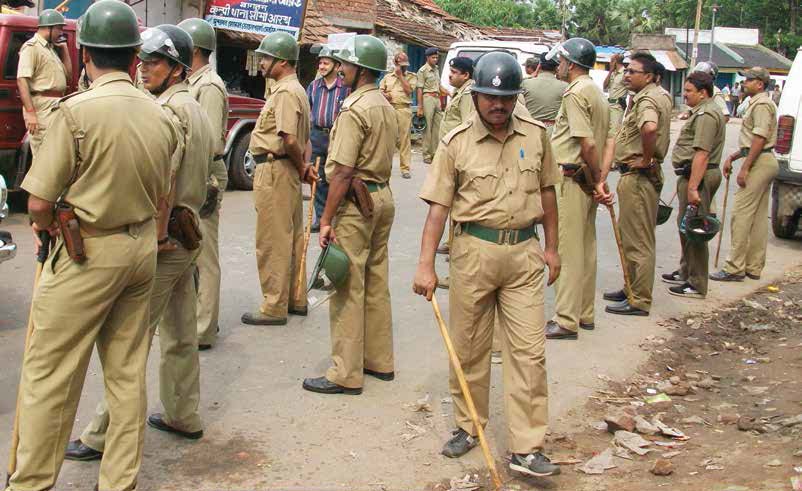This article is written by Prateek Singh, from the Institute of Law, Nirma University, Ahmedabad. It talks about cognizable offences and the act of taking cognizance of an offence.
Table of Contents
Introduction
Both substantive and procedural laws are complementary to each other, one cannot exist and thrive without the help of the other. Therefore, the Indian Penal Code and Code of Criminal Procedure are complementary to each other. IPC contains what acts and omissions will be constituted as an offence. But what to do with all the offences when one does not know how a person will get prosecuted. In such situations, the procedural laws help to guide how to proceed with a case and deliver justice in society. In layman’s terms, ‘Cognizance’ is the bridge between police which completed the investigation by filing the charge-sheet and the initiation of the trial against the accused. This article will deal with the term ‘cognizance’: what it means, who can take it and what are the limitations of taking cognizance. Further, an issue of the exercise of the power of further investigation by the magistrate will be discussed in light of the Vinubhai judgment.
Cognizance: meaning
Generally, cognizance means ‘knowledge’ or to have ‘notice’. In case of taking ‘cognizance of offence,’ it means taking notice or having become aware of the commission of an offence. Before a judicial officer can proceed and conduct the trial, he needs to take cognizance first. Taking cognizance is not a full-fledged procedure or a form that a judicial officer has to fill before conducting the trial. A judicial officer is said to have taken cognizance when a judicial officer has applied his judicial mind towards the factual matrix and related circumstances of a case, coupled with the police report to ascertain whether the charges framed against the accused are correct or authoritative and by putting the accused on trial a wrong shall not be committed.
Therefore, cognizance includes the intention of starting a judicial proceeding with respect to an offence or taking steps to see whether there is a basis for starting the judicial proceeding. It is said that before taking cognizance, the court should satisfy that ingredients of the offence charged are there or not. A court can take cognizance only once after that it becomes ‘functus officio’.
When a magistrate does not apply his mind to ascertain such a situation, he is said to not have taken cognizance. For example, ordering an investigation under Section 156(3) of the CrPC or issuing the search warrant for the purpose of the investigation, he cannot be said to have taken cognizance of offence.
It is interesting to note that the term ‘Cognizance of Offence’ is not defined in the Crpc. Sections 190-199 only deals with the methods and limitations on criminal courts to take cognizance of offence. The meaning of the term has been time and again clarified by the judiciary through various cases. In the case of R.R Chari v. the State of U.P., it was held by the Apex Court that: “Taking cognizance does not mean any formal action or expected action of any kind but occurs as soon as a magistrate as such involves his mind to the suspected commission of an offence.”
Cognizable offences
A cognizable offence is an offence in which the police officer can, for the time being, apprehend the prisoner without a warrant as per the first schedule or under some other statute, and may begin an investigation without the court’s permission. In general, cognizable offences are heinous or serious, such as murder, rape, kidnapping, theft, dowry death etc. The first report of knowledge (FIR) is reported only in the case of cognizable crimes. Under Section 154 of the Code of Criminal Procedure (CrPC), a police officer is obliged to file an FIR in the event of a cognizable offence. He can also perform some kind of preliminary investigation before registering with the FIR. For these offences, in the stipulated period, a defendant is charged and placed before the magistrate.
Key elements of cognizable offences
- Cognizable offences are those where police can arrest without a warrant.
- In such cases, the accused will be brought before a magistrate after an arrest has been made, and he may require that the police officer investigate the matter.
- Upon trial, the magistrate can order arrest if the case is resolved, i.e. the charge sheet filed goes against the accused.
- The bail application may be brought before the magistrate concerned during the pendency of the court.
- Cognizable offences are both bailable, and non-bailable.
Importance of taking cognizance
Taking cognizance is very important for securing and protecting the fundamental rights of the accused. As based on taking cognizance only, charges can be framed and a trial can be initiated. A flaw in adjudging placed before the judicial officer is crucial for someone’s life and reputation.
Methods to take cognizance
Sections 190-193 of CrPC deals with various methods by which a judicial officer can take cognizance of an offence:
- Section 190 states that any magistrate of the first class and the second class may take cognizance of any offence-
- Upon receiving a complaint of facts related to offences.
- Upon police reports of facts.
- Upon information received from a person (other than a police officer), or upon his own knowledge.
As per Section 190(2), a second class magistrate can also take cognizance if he is empowered by the Chief Judicial Magistrate.
- Section 191 deals with the situation where a magistrate takes cognizance by another person other than a police officer, or upon his own knowledge, then the accused can transfer judicial magistrate according to his desire through an application before taking any evidence.
- ‘Making over of cases to magistrates’ is dealt with by Section 192. Any Chief Judicial Magistrate can make over the case for inquiry or trial to any competent magistrate subordinate to him. The Chief Judicial Magistrate can give general or specific order to any first-class magistrate to take over the case for inquiry or trial to another competent judicial magistrate.
- According to Section 193, “Courts of Session are not allowed to take cognizance of any offence (as a court of original jurisdiction) unless the case has been committed to it by a Magistrate.” When it is expressly provided by this code or by any other law, then only Courts of Session are allowed.
Limitations
The following are the circumstances where the judicial officer cannot take the cognizance as he does normally:
- Prosecutions for contempt of the lawful authority of public servants.
- Prosecution for offences against public justice.
- Prosecution for offences relating to documents given in evidence.
- Prosecution for offences against the state.
- Prosecution for the offence of criminal conspiracy.
- Prosecution of Judges and Public Servants.
- Prosecution of members of Armed Forces.
- Prosecution for offences against marriage.
- Prosecution of the husband for rape.
- Prosecution for defamation.
Note: In case of complaints, the magistrate when issuing the process under Section 204 of CrPC, he is deemed to have taken cognizance of the complaint.
Issue of further investigation: the Vinu Bhai judgment
This judgment created ripples in the legal fraternity. The question before the court of law was that “after a charge sheet is filed by the police, the Magistrate has the power to order further investigation, and if so, up to what stage of a criminal proceeding.”
The investigation is a crucial and essential part of the criminal justice system. This case deals with the issue, whether a magistrate has the authority to order a further investigation after taking cognizance of the final report submitted by the investigating agency. To understand this we have to first consider what options are available to the magistrate when a final report is filed before the magistrate. The following are the options available:
- Accept the report and take cognizance of the offences and issue process; or
- May disagree with the report and drop the proceedings; or
- May direct further investigation under Section 156(3) and require the police to make a further report.
- While adjudging the power of the magistrate under Section 173(8), the court has unnecessarily overruled the judgment Devarapalll Lakshminarayana Reddy v. V Narayana Reddy, which held that the magistrate exercise of power to investigate granted under Sec 156(3) is only available at the pre-cognizance stage. This was erroneous as the case in hand did not deal with that provision at all.
- Secondly, it is trite to state that Section 156(3) and Section 173(8) operate at different stages of the investigation. An order under Section 156(3) commences an investigation because, in effect, it directs the police to register an FIR. Section 173(8) in contradistinction applies after the completion of an investigation, which is signified by the filing of a police report (or charge sheet) under Section 173(2).
- Therefore, there was no need to deal with this issue whether the provision of Section 156(3) can be exercised at the pre or post cognizance stage.
- The contention was whether the power to investigate further lies only with the investigating agency under Sec 173(8) and the magistrate may permit the agency to conduct such investigation when an appropriate application filed before it.
- The court referred to various cases, both, in favour and against the use of Section 173(8) by the magistrate. After, referring to all this, the court referred to the 1976 amended legislation whereby this 173(8) was inserted.
- As per Section 2(h) of the CrPC, ” investigation” includes all the proceedings under this Code for the collection of evidence conducted by a police officer or by any person (other than a Magistrate) who is authorised by a Magistrate in this behalf.
A bare reading of the section denotes that the term ‘investigation’ has been widely interpreted by the legislation and therefore, to narrow down the interpretation would be the travesty of justice. Furthermore, the power under Section 173(8) is a separate authority independent of the existence of Section 156(3). Hence 173(8) can be exercised by a magistrate keeping in mind the cause of delivery of justice.
Conclusion
Hence, criminal law has always been the most effective branch of the law, helping to deal with the most brutal of crimes and protecting society from falling into the state of anarchy. It is composed of two divisions known as substantive law and procedural legislation. The main aim of criminal proceedings is to provide the accused with a complete and fair jury, in compliance with natural justice standards. There are different steps to be taken to dispense justice and get the culprit to the book.
Section 154 of the CrPC states that, in the event of a cognizable offence or incident, the police officer shall receive the First Information Report (FIR) on the cognizable offence, which may be obtained without the permission of the Magistrate, and enter it in the general diary for immediate commencement of the investigation. An FIR triggers criminal law. If a cognizable crime is committed, a police officer can investigate without authorization from the magistrate. Any First Class magistrate and any Second Class magistrate can acknowledge any offence. Section 190-199 of the Code describes the methods by which various criminal courts are entitled to take cognizance of offences, and the limitations under which they are entitled.
References
- http://www.helplinelaw.com/employment-criminal-and-labour/CCPC/cognizable-offence-criminal-procedure-codecrpc.html
- https://www.lawhousekolkata.com/2019/03/09/what-is-a-cognizable-and-non-cogniza b le-offence-in-india/#:~:text=Cognizable%20offences%3A,the%20 permiss i on %20o f %20the%20court
- https://www.soolegal.com/roar/cognizance-of-offences-under-code-of-criminal-procedure#:~:text=Literally%2C%20it%20means%20’to%20be,an%20offence%20for%20the%20purpose
- https://www.lawyerservices.in/RR-Chari-Versus-State-of-Uttar-Pradesh-1951-03-19
- http://www.legalservicesindia.com/article/2499/Cognizance-by-a-Magistrate:-Meaning-and-Concept.html
- https://www.legalbites.in/limitation-taking-cognizance-certain-cases/
- http://kanoon.nearlaw.com/2017/12/29/limitation-period-criminal-procedure/
- https://www.barandbench.com/columns/critique-of-the-supreme-court-judgment-in-vinubhai-haribhai-malviya-ors-v-state-of-gujarat
- https://www.lexology.com/library/detail.aspx?g=fe6e7d8e-a49b-44ee-a73c-fa8f8ff182ff
LawSikho has created a telegram group for exchanging legal knowledge, referrals and various opportunities. You can click on this link and join:
 Serato DJ Crack 2025Serato DJ PRO Crack
Serato DJ Crack 2025Serato DJ PRO Crack











 Allow notifications
Allow notifications



